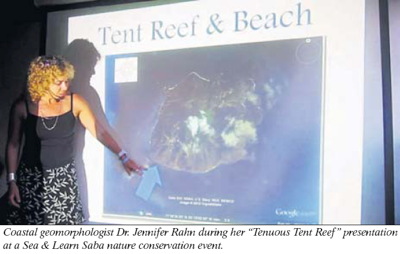The Daily Herald reports that coastal geomorphologist Dr. Jennifer Rahn held a presentation on the tenuous situation of the Tent Reef during an evening Sea & Learn Saba event hosted by Sea Witch restaurant in Windwardside, Wednesday, October 23. She said that the island government seeks Dutch government nature conservation funding to save Saba’s dive tourism and mitigate the hazardous soil-fill erosion threatening Saba’s signature Tent Reef dive spots. The landfill threat created by public works soil dumping along the Tent Beach requires the costly relocation of some 3,000 truckloads of clay, construction debris and silt sediment not natural to the beach front.
Dr. Rahn is the director of the Environmental Studies Scholars Program of Samford University, Alabama. She first landed on Saba’s shores in 1991 as a dive master and now makes frequent research trips in which she often brings her American students. Her base-line topographic and bathymetric information research includes a quarterly survey of Tent Reef Beach next to the Fort Bay harbour. This summer she worked on the GPS and sonar 3D mapping of Saba’s famed marine pinnacles, on Tent Bay and Wells Bay beaches.
Her lecture briefed on the reports she issued in 2011 and 2012 on the implications of dumping concrete and soil-fill on Tent Reef Beach and the joint letter issued in May 2012 with dive operators to the island government. In July 2013 these alarm assessments were validated by independent Dutch consultants. This ultimately triggered the island government to submit a Tent Reef Protection project as one of the top three proposals likely to receive national funding. The first April 2011 report issued by Rahn noted that according to Saba Marine Park diving statistics from 1996 to 2009, 18 per cent of all diving is done in Tent Reef dive sites. In 2012 this figure rose to 26 per cent of all dives.
For a long time all Saba dive business operators preferred to keep lobby discussions with the government behind closed doors. In August 2012 The Daily Herald publicized Rahn’s joint efforts with the Saba Conservation Foundation and the business owners’ plea against the soil smothering of marine live sites and corals in the top tourist dive attractions. The newspaper alerted at the time on the sustained practice of discarding soil from public construction sites photographing trucks dumping directly into the water. Susceptible to collapse, the massive dumping-fill is loosely compacted with an unstable steep slope exposed to rainfall erosion and undercutting large waves or swells.
Rahn spoke of the clay sedimentation settling time and suspension different to the natural volcanic rocks and showed how a sample of the dumped clay only settles in under 6 hours in completely still water. The high erosion rate and water turbidity caused by these clay sediments is compounded by their tendency to retain rainwater, break and create landslides. The long-term water turbidity will be harmful to the Tent Reef coral reefs. Rahn said the Saba government recently submitted the Tent Reef protection project whose overall objective is to eliminate the imminent threat that the dumped debris from the harbour project poses for Tent Reef as part of the protected marine area. The government intends to relocate the debris from the current area to a site in the vicinity, owned by private owners. The envisioned stabilization of the reallocated sediment will not be an ideal site. When asked why, Rahn said this chosen relocation site was the government’s choice. Due to the main direction of water currents, soil discharge from the new site may yet be a threat but other higher- elevation suggested sites off the coast were found to be “cost-prohibitive.” The government plans to have the project act as a recreational area.
The community is called to play an active role. This month the Organoponics garden team and the Second Chance (SKJ) students of the Foundation Social Workplace Saba (FSWS) helped Dr. Rahn conduct measurements at the relocation site. The goal was to identify a sustainable level of controlled runoff erosion that would make the project cost-effective. Organoponics agricultural engineer Otto Anderez advised on suited plants to control erosion. The project will commence after expected ministry approval, likely in January 2014 and will take 7 months. Rahn hopes the project will finalize and vegetation may stabilize the new fill preferably before the next hurricane season. Asked if the government’s raised awareness will act as future deterrent, Rahn commented only that “It is cheaper to do it right the first time than to fix it up. This will not be a cheap remediation project.”

 Archive of posts from Saba-News.com Archive Saba News
Archive of posts from Saba-News.com Archive Saba News